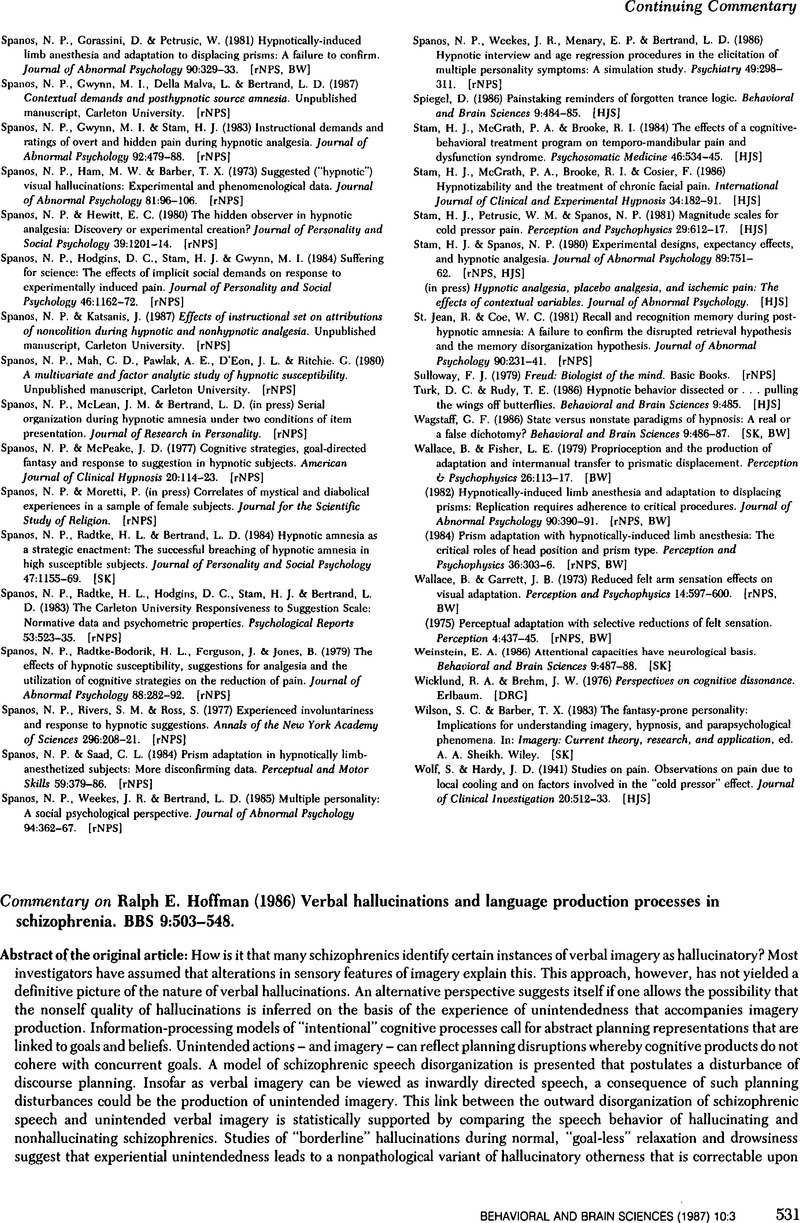Crossref Citations
This article has been cited by the following publications. This list is generated based on data provided by Crossref.
Dougherty, George G.
Steinhauer, Stuart R.
Zubin, Joseph
and
van Kammen, Daniel P.
1991.
How does the physiology change with symptom exacerbation and remission in schizophrenia?.
Behavioral and Brain Sciences,
Vol. 14,
Issue. 1,
p.
25.
Pilowsky, Lyn
and
Murray, Robin M.
1991.
Why don't preschizophrenic children have delusions and hallucinations?.
Behavioral and Brain Sciences,
Vol. 14,
Issue. 1,
p.
41.
Goldberg, Elkhonon
1991.
Schizophrenia and stored memories: Left hemisphere dysfunction after all?.
Behavioral and Brain Sciences,
Vol. 14,
Issue. 1,
p.
30.
Early, Terrence S.
Haller, John Wayne
and
Posner, Michael
1991.
Dopaminergic excess or dysregulation?.
Behavioral and Brain Sciences,
Vol. 14,
Issue. 1,
p.
26.
Crider, Andrew
1991.
Motor disturbances in schizophrenia.
Behavioral and Brain Sciences,
Vol. 14,
Issue. 1,
p.
22.
Spohn, Herbert E.
1991.
A plausible theory marred by certain inconsistencies.
Behavioral and Brain Sciences,
Vol. 14,
Issue. 1,
p.
49.
Patterson, Terry
1991.
A realistic model will be much more complex and will consider longitudinal neuropsychodevelopment.
Behavioral and Brain Sciences,
Vol. 14,
Issue. 1,
p.
40.
Carlsson, Arvid
and
Carlsson, Maria
1991.
A faulty negative feedback control underlies the schizophrenic syndrome?.
Behavioral and Brain Sciences,
Vol. 14,
Issue. 1,
p.
20.
Gray, J. A.
Hemsley, D. R.
Feldon, J.
Gray, N. S.
and
Rawlins, J. N. P.
1991.
Schiz bits: Misses, mysteries and hits.
Behavioral and Brain Sciences,
Vol. 14,
Issue. 1,
p.
56.
Oke, Arvin F.
and
Adams, Ralph N.
1991.
Is another loop needed to explain schizophrenia?.
Behavioral and Brain Sciences,
Vol. 14,
Issue. 1,
p.
39.
Raine, Adrian
and
Cannon, Tyrone D.
1991.
Neuro-developmental, brain imaging and psychophysiological perspectives on the neuropsychology of schizophrenia.
Behavioral and Brain Sciences,
Vol. 14,
Issue. 1,
p.
43.
Swerdlow, Neal R.
1991.
Neuropsychology of schizophrenia: The “hole” thing is wrong.
Behavioral and Brain Sciences,
Vol. 14,
Issue. 1,
p.
51.
Sandyk, Reuven
and
Kay, Stanley R.
1991.
The significance of the basal ganglia for schizophrenia.
Behavioral and Brain Sciences,
Vol. 14,
Issue. 1,
p.
45.
Dawson, Michael E.
and
Hazlett, Erin A.
1991.
Heterogeneity, orienting and habituation in schizophrenia.
Behavioral and Brain Sciences,
Vol. 14,
Issue. 1,
p.
24.
Williams, Jonathan H.
1991.
The neuropsychology of schizophrenia: In step but not in time.
Behavioral and Brain Sciences,
Vol. 14,
Issue. 1,
p.
55.
Manschreck, Theo C.
and
Maher, Brendan A.
1991.
Approximations to a neuropsychological model of schizophrenia.
Behavioral and Brain Sciences,
Vol. 14,
Issue. 1,
p.
36.
Elkins, Irene J.
and
Cromwell, Rue L.
1991.
A focalized deficit within an elegant system.
Behavioral and Brain Sciences,
Vol. 14,
Issue. 1,
p.
27.
Pisa, M.
and
Cleghorn, J. M.
1991.
A heuristically useful but empirically weak neuropsychological model of schizophrenia.
Behavioral and Brain Sciences,
Vol. 14,
Issue. 1,
p.
42.
Claridge, Gordon
and
Beech, Tony
1991.
Don't leave the “psyche” out of neuropsychology.
Behavioral and Brain Sciences,
Vol. 14,
Issue. 1,
p.
21.
Hestenes, David
1991.
A cardinal principle for neuropsychology, with implications for schizophrenia and mania.
Behavioral and Brain Sciences,
Vol. 14,
Issue. 1,
p.
31.



